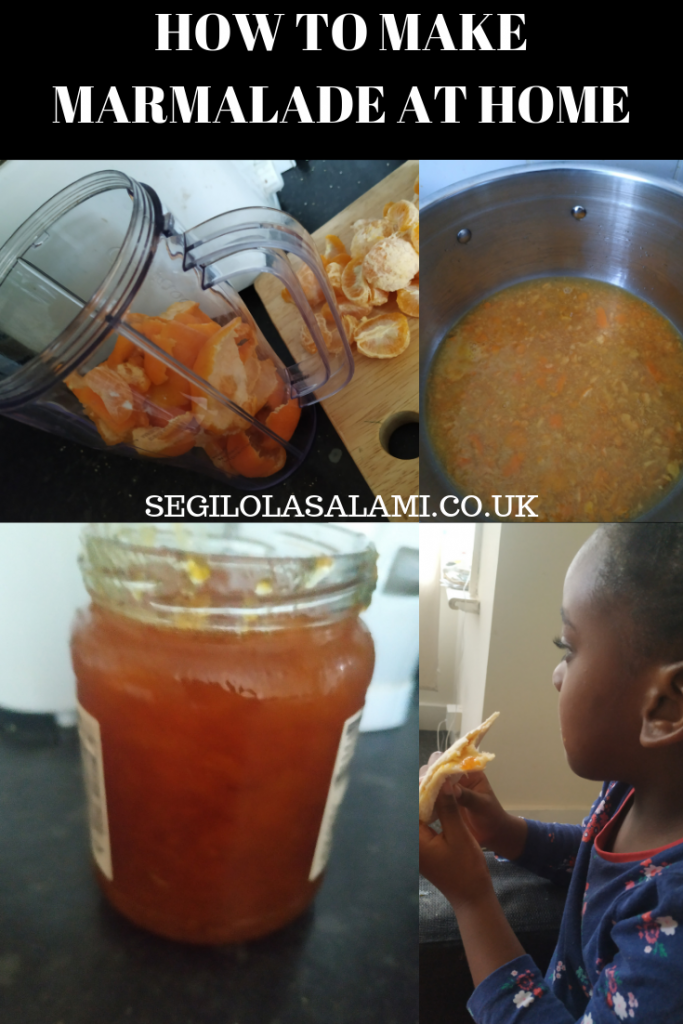A few months ago, I bought a dwarf citrus fruit tree, of some kind, for my garden. Unfortunately, when the fruits ripened, they were not sweet to taste. Me being me, I really hate wastage and could not bear to throw away so much fruit. Also, as a mother, I know that my daughter watches all my actions and telling her that we threw away fruits because they were not sweet did not sound like a good enough excuse to me. After a good few days thinking of a solution, it hit me. We can actually make our own marmalade and when we did, it was delicious! So permit me to share with you my recipe on how to make marmalade at home using regular oranges or similar eg tangerines, satsumas.

RECIPE: How to make marmalade at home using regular oranges
INGREDIENTS
Oranges (or similar eg tangerines)
Tap water
Granulated Sugar
Glass bottle(s)
PREP TIME: 5 – 10 minutes
COOKING TIME: 75 minutes
After a quick Google search, I got to me know that calamondin citrus (which is the plant I bought) normally tastes sour.
METHOD
- After watching lots of videos and reading lots of recipes on how to make marmalade, I noticed that people spent a lot of time chopping the peel. As a parent, time is a priceless commodity to me, so I popped the peel from a bowl of calamondin citrus oranges and blitzed them once in my smoothie maker. The peel got to the top of the 500ml mark of the smoothie maker bowl and I added enough tap water to reach the 500 ml mark.
- I transferred the blitzed peel and water into my large stainless steel pot and set it to boil on high (gas mark 7)
- Whilst the peel was boiling, I set to de-seeding the actual fruit. I also removed the pith. It took me about 30 minutes to do this and by this time, most of the water in the pot had reduced
- I touched a couple of peel and found that they were not as tender as I needed it, so I added another 500 mls of tap water and continued to boil it
- After a further 5 – 10 minutes, I checked the peel again and found that it was soft enough
- I reduced the heat of the fire to low (gas mark 2) and added the calamondin citrus fruit. In some recipes, the fruit was not added to the pot directly, instead it was put in a muslin. After the cooking process, the left over shaft was taken out with the muslin. I decided to include the fruit in my recipe because, like I said, I hate wastage. Also, I believe it’s all extra fibre, which can only be a good thing
- I initially wanted to add in about 500g of granulated sugar but after pouring roughly half into the pot, I tasted the solution and found it was sweet enough for my tastes. I asked my daughter to taste it also and she agreed that it was sweet enough
- I stirred the granulated sugar mixture gradually until it dissolved completely. I had read that it was important to do this on low heat to ensure that the sugar dissolved completely. Once the marmalade was ready, it would be taste very gritty if the sugar did not dissolve completely
- I left the solution to cook for another 30 minutes with the occasional stirring
- You know the marmalade is about to get ready once the solution takes on a deep yellow/orange colour and starts to bubble. The mixture also looks like it is about to caramelise and thickens a bit
- Like I mentioned before, I hate wastage, so I had kept the bottle from the last bottle of honey we used. Using a cooking spoon, I poured the hot marmalade into a glass bottle (about 400g) and set it on my counter top to cool down
Going through the process of making marmalade for the first time made me realise when jam is called jelly in the US. The process of making both is very similar. The main difference is that jelly in the UK is smooth and does not have any cooked fruit in it, although you can add fruit pieces in it before it sets.
The proof of the taste is in the eating (someone or the other said). My daughter tasted the freshly made orange marmalade with a slice of bread and gave it her seal of approval. As a parent, that is all that matters to me.
One of the things I like about cooking is that you can always amend a standard recipe to fit in with your own needs and tastes. Whilst this recipe does not use the regular Seville oranges, it goes to show that you can also use everyday oranges to make your own marmalade at home. I imagine myself making an orange marmalade cake with this recipe hmmm yum yum
If you would like to try this RECIPE: How to make marmalade at home using regular oranges, please purchase the ingredients using my Amazon affiliate links below




